

Altered Hair - Overview
Sources
Search
Contact
Home
The Altered Hair Varieties
The analysis of the 1881-O series and hair has become so interesting that we are changing our approach to this section and only including images of the hair. At this juncture we are not including the hair on the upper portion of the bust because this would just become too complex and it is higher in the relief and less susceptible to the type variations in the lower hair.
At first we thought there were only six coins with polished out or weakly struck lower hair characteristics. However we now know the issue is much broader any much more complex. The hair state is also so distinguishing that you can sometimes identify a VAM or small group of VAMs by only looking at the hair. This has become a bit like recognizing a friend by his or her hairdo.
To understand the lower hair you must visualize the Liberty bust as if it were lying on a surface and has the ability to sink into the surface. As it sinks fewer of the features are completely visible, and detail starts to disappear around the edges.
All coins are like relief carvings. But when a die is polished it is polished from the field toward the highest relief portion. So the detail disappears first in the lowest relief areas, which is often around the edges. But low relief areas can be anywhere that the engraver wanted to create depth.
On a Morgan Dollar, in the lower hair, these areas are around the edges. But there are also low relief areas just below the designer's initial, in the hair vees, and the back of the cap.
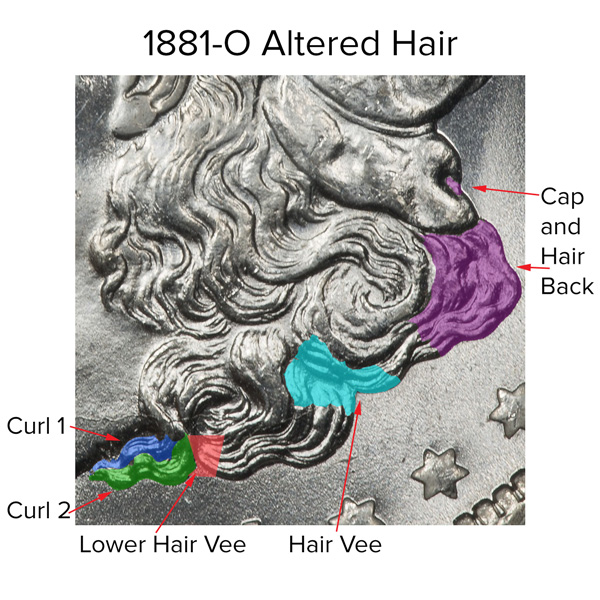
Clashed Dies
Gouge in DOLLAR
Double Ear
Overpolished Wings
Altered Hair
Spiked 8
Similitudes
The Concept
Bearded Eagles
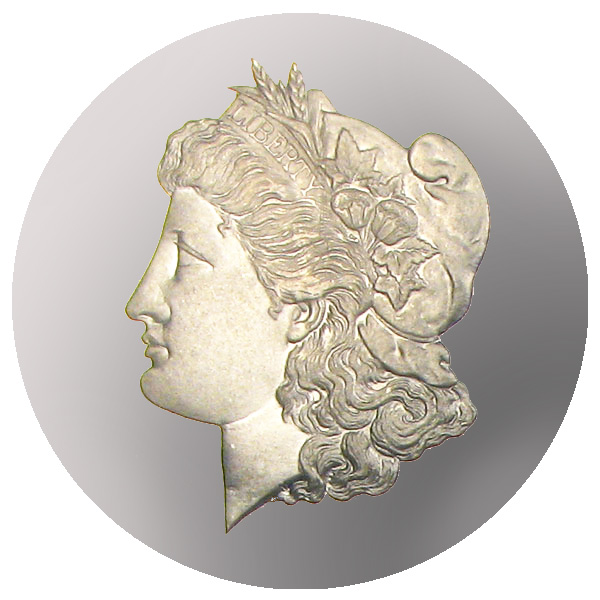
The Real Morgan Dollar
What should the hair on a Morgan Dollar look like?
As basic as this question sounds, it is a little more difficult to answer than one might imagine. We looked for a long time to find one that we thought was representative of George Morgan's original design, and even this coin has an issue or two.
First where the two hair curls come together below the designer's initial, and they should come together into a point that fits neatly beside the neck. This is a low relief area, so even on high grade coins this point is often polished out by just the least polishing. When it is missing there is a small concave area at the base of the neck that indicates where the hair should have terminated. This happens so often that most collectors believe the two curls were designed to end in a soft circle.
The area just below the designer's initial is also very low. So the upper curl often gets polished out in a manner that looks like a truncated curl or one that stops and starts. As polishing continues it actually starts to erode the initial from the bottom.
The bottom curl is higher relief, so it lasts longer. But it can get polished out and in the extreme begins to look like a "Loch Ness Monster." Usually when this happens other features also erode such as the hair vees.
The two hair vees are low relief at the vee junction. When presented as intended the hair from each direction comes together and touches to create the vee. When polished the junction begins to appear open as lower relief detail disappears.
At the back of the hair and cap the hair is sometimes polished out where the hair and cap meet the field, but not into the hair. There is a small cap fold where the relief is very low and it tends to disappear with the hair edge. Loss of detail once you leave the hair edge is usually from incomplete or weak strike and not polishing.

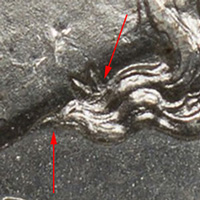
Full Curls
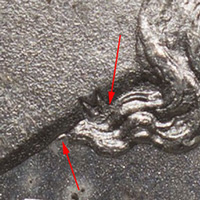
Chattered Curl 1
Full Curl 2
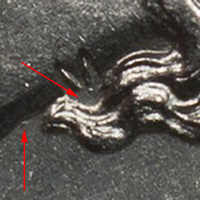
Hollow Curl 1
Full Curl 2
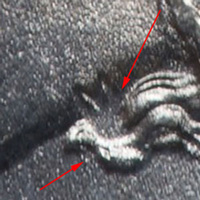
Broken Curl 1
Narrowed Curl 2

Broken Curl 1
Broken Curl 2
Analysis Groupings
A Note of Caution
Features Not Analyzed
Finding logical hair groupings has not been easy, so we decided to start all definitions with the two curls below the designer's initial. These groupings carry other associations with hair vees and reverse hair-cap types. A benefit of using this feature is that it is front and center and catches your eye immediately when you look at the coin.
Full Curls - The two curls come to a point below the neck and are complete to nearly complete.
Chattered Curl 1, Full Curl 2 - The top curl is continuous but polished so that there is an opening below the designer's initial. That opening is usually filled with the remnants of the top of curl 1 as it lost definition.
Hollow Curl 1, Full Curl 2 - The top curl is continuous but polished so that there is an opening below the designer's initial. This opening is clear of detail.
Broken Curl 1, Narrowed Curl 2 - The top curl is abbreviated so that there is a gap before and after the designer's initial, but the bottom curl has started to narrow.
Broken Curl 1, Broken Curl 2 - The top curl is shortened and the bottom curl is completely broken in places.
There is no guaranteed one-to-one hair state that is associated with a single VAM. Since the hair state is associated with degree of polishing of the obverse die, multiple states can exist for any one VAM. The more a die was used and repeatedly polished without changing the die parings, the more likely multiple states exist for a VAM.
In fact, our descriptors probably correlate closely to very early to very late die states. But those do not help collectors understand what they are actually seeing, so we opted for physical characteristics instead.
Our inventory includes enough coins to draw some conclusions about the common associations. Every attempt has been made to find this common association, but our analysis is limited to our inventory.
Please use this data as a "jumping off point" into your study and not a final definition of VAM. This data can also be used to verify whether or not we have seen a particular hair state on a die.
Where we lack inventory we did not include the VAMs in the analysis. This leaves only a few VAMs as "missing in action," but we will fill them in as we find them.
However, since this analysis is based on degree of polishing of the obverse die there is something to be learned here for all Morgan varieties.
Once you begin to focus on any area of a Morgan Dollar there are variation and similarities that are easily confused with dies but they are actually strike issues.
The most common feature we have seen is the area behind the ear. On the example above you can see that the hair was intended to look like individual ringlets of hair that run from the back of the ear down. Often these are blended into a molten mass that looks like melted metal.
We believe this is a strike issue where the metal did not completely flow into this high relief area of the design. We also believe this was most likely caused by improper strike pressure or force and not "light" planchets since they were weighed prior to striking.
There is a large lock or tress of hair that comes straight down from the earlobe that is also often weak in appearance. This too is a high relief area and the lack of detail is probably a strike issue. In fact we have only seen one coin where we thought this feature was struck as intended so it is likely very high in the relief.
Getting Started
Collecting The 1881-O
The 1881-O VAMs




















